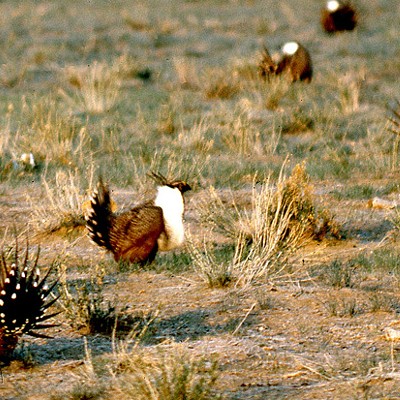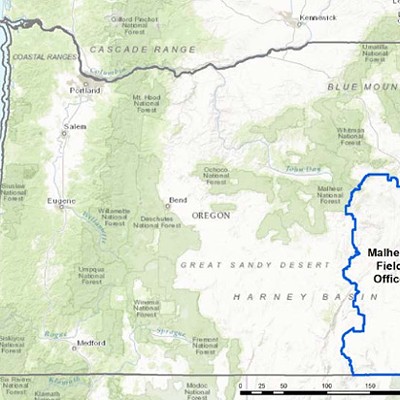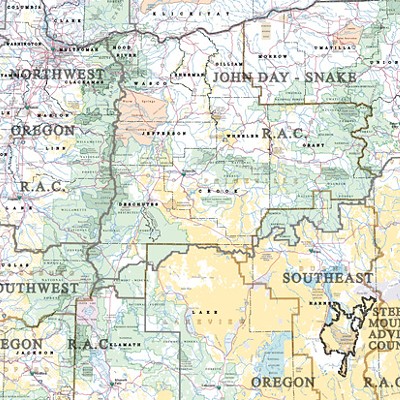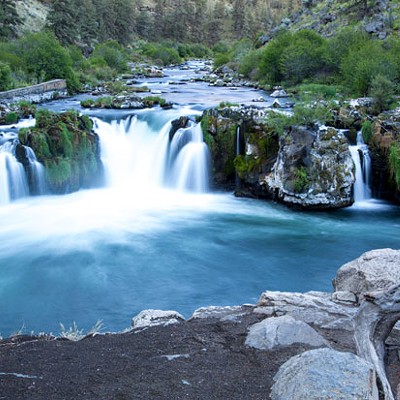As the Bureau of Land Management continues its roundup of 1,500 wild horses in the Beatys Butte herd management area in Southern Oregon—one of the largest gathers in state history—agencies that manage the iconic species are under increased scrutiny.
A little over a week before the roundup began, the Department of the Interior released a report finding that the largest buyer of wild horses from the BLM—a Colorado rancher named Tom Davis who BLM records show purchased 1,700 horses since 2009—has been illegally selling horses to "kill buyers."
"During our investigation, Davis admitted that most of the horses that he purchased through [the Wild Horse and Burro program] ultimately went to slaughter," the Oct. 23 report states. "We determined that BLM did not follow current law while managing WH&B. BLM also failed to follow its own policy of limiting horse sales and ensuring that the horses sold went to good homes and were not slaughtered."
According to the report, the U.S. Attorney's Office for the District of Colorado and the State of Colorado Conejos County District Attorney's Office both declined civil and criminal prosecution.
In the court of public opinion, however, the revelation is fueling existing skepticism about the program's ability to responsibly and humanely manage wild horse and burro populations.
It all started more than 40 years ago, when Congress adopted the Wild Free-Roaming Horses and Burros Act of 1971. At the time, the wild equine population had dipped to about 17,000 from the millions believed to roam the American West at the turn of the 20th century. Lawmakers stepped in to stop the decline and preserve the animals' revered place in the American imagination.
In the introductory text of the Act, Congress "finds and declares that wild free-roaming horses and burros are living symbols of the historic and pioneer spirit of the West; that they contribute to the diversity of life forms within the Nation and enrich the lives of the American people; and that these horses and burros are fast disappearing from the American scene."
Today, "fast disappearing" could be replaced with "fast populating." The Act was successful in supporting the growth of wild horse populations, and by 1983, an estimated 65,000 horses and burros were grazing on rangelands.
But the Act also calls for balancing wild equine populations with the capacity of the land to support them. And the environment has changed since the days when wild horses roamed free. So the BLM started subtracting from their numbers. Today, the population of wild horses hovers around 35,000, with roundups culling about 9,400 horses each year nationwide.
"Overpopulation of wild horse herds can have serious impacts on the land and the animals," explains Jason Lutterman, spokesman for the BLM's Wild Horse and Burro Program. "Over-population causes over-grazing, soil erosion, damage to springs and streams, and can cause horses to starve and can impact the long-term health of the land and other wildlife species that share it with horses and burros."
He says that the BLM has few tools to address the growth of wild horse and burro populations. With virtually no natural predators, Lutterman says, their herds can increase by 20 percent each year, doubling in size within five years without human intervention.
And so, the government steps in. The 1971 Act, and its updates later that decade, grant the Departments of the Interior and Agriculture through the BLM and U.S Forest Service the authority to achieve "appropriate management levels"—a concept to which firm numbers are attached—by "removal or destruction" as well as by sterilization or other "natural controls."
While these agencies, specifically the Bureau of Land Management and the National Forest Service, are tasked with first attempting to adopt the "excess" horses to people who can provide proper care for them, they are directed to destroy those not adopted "in the most humane and cost-effective way possible." That does not include selling the remains of said horses for any commercial use.
But there aren't as many people able and willing to adopt the horses as there are horses available for adoption. The BLM wild horse holding areas are filling up. And though the law prohibits it, as the investigation into Tom Davis shows, some wild horses still wind up at slaughterhouses.
Critics say that the fatal flaw in the government's approach to managing the species is that they are viewed as an invasive species, not unlike juniper, which despite its somewhat iconic status in the high desert, can take over a landscape if left unchecked.
"Unfortunately, the conventional approach to wild horse management has been to treat them as invasives," explains Gayle Hunt, president and founder of the Central Oregon Wild Horse Coalition. "If wild horses are viewed in this way, their management can never be more than a feeble and transparent attempt to comply with a nuisance law, which protects a nuisance species."
It would be different, she says, if wild horses were viewed with "the same respect" as sage-grouse, pronghorn, and other iconic local species. The challenge, Hunt explains, is that humans have made it nearly impossible to simply let things return to their "natural" state. Too much has changed, and now nature must be actively managed in order to resemble its roots.
"Because true 'Nature' hasn't existed since the livestock occupation of the 19th century, we have to intervene to attempt balance, and still it probably isn't something we can ever reclaim," Hunt says. "But the first thing conservationists, biologists, botanists, and everyone who cares about the West must do is come to terms with the fact that horses are not invasives."
But that's a point of some contention. Unlike other native species, horses haven't enjoyed an unbroken chain of wild existence in North America. While some research suggests that the horses now roaming the wild are direct descendants of horses that lived on the continent tens of thousands of years ago, there was a large chunk of history when they either left the area or existed in such small numbers that their presence is hard to trace. Wild horses are more recent relatives of the domesticated horses brought over from Spain in the 1400s, who may or may not have interbred with any remaining wild bands.
"Native status for wild horses would place these animals, under law, within a new category for management considerations," explained Jay F. Kirkpatrick, director of Montana's Science and Conservation Center, in a 2005 statement in support of a bill to ban the sale of wild horses for commercial uses. "As a form of wildlife, embedded with wildness, ancient behavioral patterns, and the morphology and biology of a sensitive prey species, they may finally be released from the 'livestock-goneloose' appellation."
Gayle Hunt, of the Central Oregon Wild Horse Coalition, explains that the best approach is balanced and collaborative. She points to her organization's work with the Ochoco National Forest, which manages a smaller Big Summit band of wild horses in Central Oregon, about 25 miles east of Prineville.
"In the Ochocos, we have a sort of crucible for testing variations on the current practices because of the number and quality of committed volunteers, the fact that the herd is managed by the Forest Service, and the open minds of the local Forest Service wild horse staff to demonstrating a different way," she explains.
Hunt says she understands that the herds must be managed, but believes that through a combination of temporary fertility control options; smaller, low-trauma captures; and capitalizing on natural herd behaviors, population growth can be kept to 7-8 percent—without resorting to larger gathers that use helicopters to chase the horses into traps. She is hopeful that wild horse advocates and the Forest Service can find common ground and mutually supported strategies.
And that process is opening up to greater public input as the U.S. Forest Service seeks to revise its own 40-year-old management policies. The three-year effort will include a monthly stakeholder group that's open to the public. The Ochoco National Forest (ONF) is inviting interested parties to stop by its office in Prineville between noon and 7 pm Nov. 17 to get more information.
courtesy of the Bureau of Land Management


























